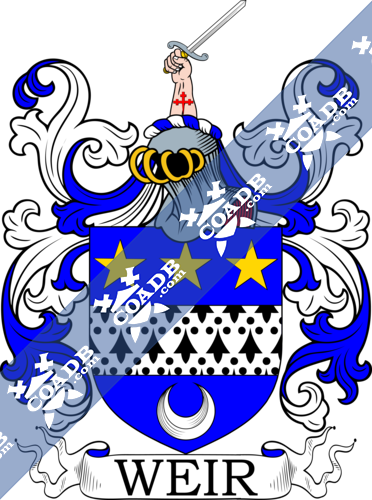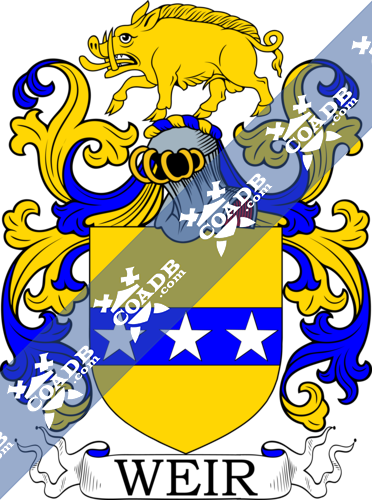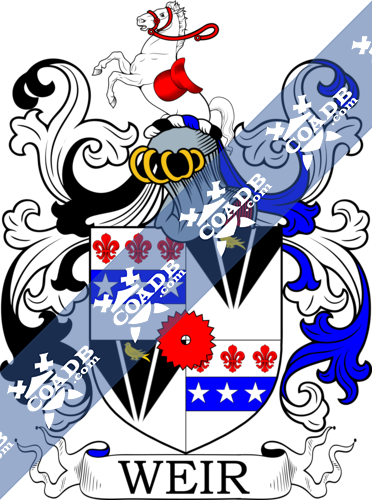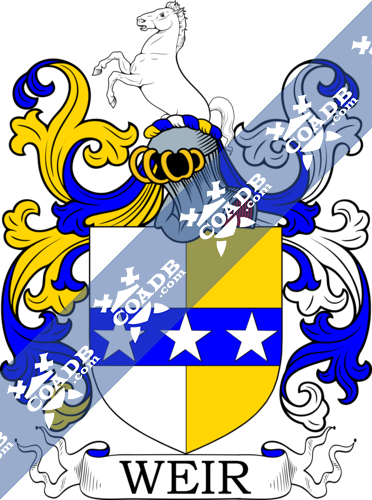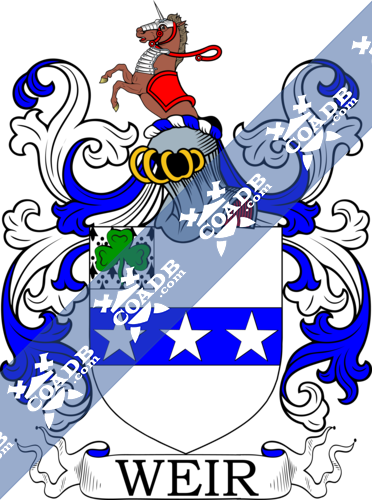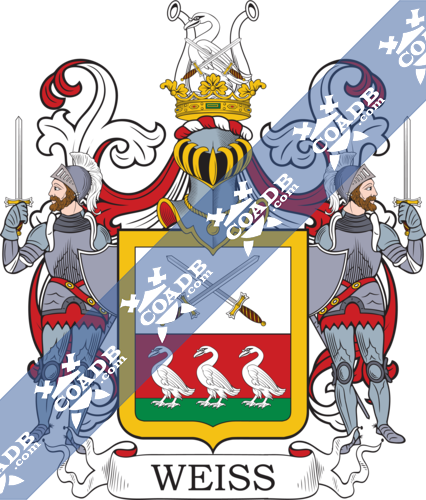Weir Family Crest, Coat of Arms and Name History
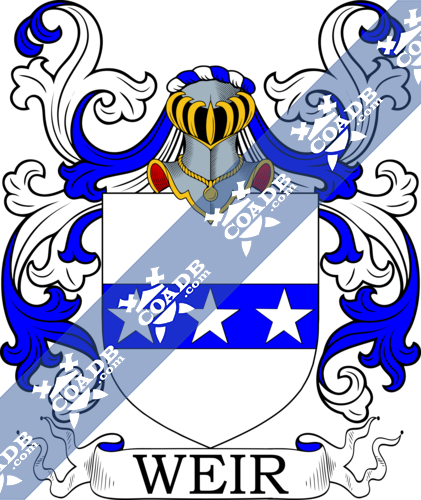
Weir Coat of Arms Gallery
Don’t know which Coat of Arms is yours?
We can do a genealogical research. Find out the exact history of your family!
Learn MoreWEIR
Weir is a name which is thought to originate from the north western portion of medieval France, just below Brittany. A topographical name It was originally spelled de Ver , while a similar spelling came with the Norse warriors who settled along the French coast line from Le Treport to St-Malo. A Wyr or Weir was a medieval device which when placed in a river channels fish into a woven net or basket. It could also mean a meeting place. A German variant of the name is Wire.
Surnames in Britain prior to the Norman conquest were largely unheard of. In the small settlements and villages which existed during earlier times, residents found little need for surnames as everyone in these communities new each other and a given name would usually suffice. However, with the passage of time, population growth and expansions of communities as villages gave way to towns and cities, it became necessary to add a qualifier to a people’s names to distinguish them, one from another. Therefore one person may have been identified by their given name plus their occupation while another may have been identified by their given name and one of their parent’s names. The introduction of surnames by the Norman aristocracy after the invasion seemed to be the next logical step in this evolution. There was a boundless supply from which surnames could be formed, in addition to the use of patriarchal/matriarchal names or reference to the individuals occupation, there were things such as defining physical traits, a familiar geographical location or a topographical landmark found near the individuals home or birthplace, the name of the village in which the person lived, and so much more. Soon, surnames would come not just to represent an individual but whole families.
There often exists variations in spelling of many surnames, as with many given names which date back to the early centuries. The variation in spelling of both given and surnames during this time period can be attributed to a lack of continuity regarding guidelines for spelling which was compounded by the diversity of languages in use in European countries at this time. The variations in the spelling of the surname: Wear: Weir; Wier, Wire; Wryer; Ver, de Ver and Vere.
Sir Ralph ( Ralf, or Radalphus)-There are multiple spellings, de Ver is recorded as being King William the Lion of Scotland’s battle companion in 1174 AD at the battle Alnwick, where they were both captured trying to wrest control of Northumbria away from English control. Sir Ralph de Ver appears as signing witness to the treaty of Falaise, which allowed William the Lion to have his freedom at the cost of loosing all rights to the northern England. It should also be noted the Weir family was not the only Norman lowland clan to build up their castles, and clansmen in the lowlands of Scotland, as Clans Bruce; Douglas; Fraser, and Stirling all have their roots in Normandy; but by the 14th century, what might have started as Norman knights adventuring, had become Scottish clans and families who fought fiercely in the Scottish wars of independence.
The Weir family became one of the early converts to what would become the Protestant church, with a Lanarskshire Weir named, Thomas Weir, Major. Who served in the Protestant army of the Covenant who shipped over to Ireland to protect the protestant plantations in the north of Ireland in the 1600’s. Many a dark and foul deed was placed before his name. The troops called him the Bowhead Saint for his actions. A saint at the time, was a euphemism for someone who was a zealot in their persecutions of non-protestants, chiefly being the Irish catholic citizens under the English covenant army. Bowhead is a location in Edinburgh, Scotland where he once resided. In the later years of his life, his foul deeds were made public and he was one of the last people in Scotland to be tried and sentenced to death by burning as a witch.
With the expansion of the British interest in Ireland and abroad, the Weir family members were some of the first to immigrate to different lands to make their fortune. Large number of Weir clansmen moved to Northern Ireland as part of the English/Protestant resettlement program enacted during the later half of the 1600’s. Ulster protestants came to America in the 1600’s and 1700’s in a steady flow to what were then considered the English colonies, Massachusetts; Virginia; and South Carolina. Martha Weir age 21 with her son John Weir age 1 traveled from Rotterdam Charleston, SC in 1766, originating out of Londonderry, Ireland. One of of the 3 times removed ancestors of President George Walker Bush was a certain James Hutcheson Weir born in Virginia in 1789, and died in 1832 in Cooper, County Missouri in 1832.
The Weir family has a long and storied history. They have been knights, baronets, witnesses to history, large land holders, and workers of the soil. The Weir surname has split many times, and their surname has been adopted or hyphenated to keep familial inheritances alive. Notably the Parliamentarian Hope-Weir, who married the sole child or Sir William Weir, and it is through this union the Blackwood estates of Lanarkshire retained the Weir surname. Weir family members have through their efforts managed to spread themselves and their descendants to the farthest reaches of the globe. They have even helped to create the lineage of two American Presidents.
Notable persons associated with the surname of Weir:
King William I of Scotland; David I, David II, Robert the Bruce, William of Orange, Queen Mary, James II, Presidents George Walker and George Herbert Bush, Bob (Robert) Weir musician with the Grateful Dead.
Places associated with the surname of Weir:
Lanarkshire, Edinburgh, Scotland. Calvados, Normandy France. House of Parliament, London, Weir Bedfordshire, England. Weir, Texas, Kentucky, Kansas, Missouri, and Nebraska USA.
Blazons & Genealogy Notes
1) (certified at Herald’s Coll. May, 1779). Az. a fess erm. hetw. three mullets in chief or, and a crescent in base ar. Crest—A cubit arm erect ppr. holding in the hand a sword ar. hilt and pommel or, on the arm a cross crosslet fitchee gu.
2) (Weir-Vere). (Stonehyres, Scotland). Motto—Yeio nihil verius. Or, on a fess az. three mullets ar. Crest—A boar pass. or.
3) (Blackwood, co. Lanark). Ar. on a fess az. three mullets of the field.
4) (Crookedholm, co. Ayr, 1672). Per pale ar. and or, on a fess az. three mullets of the first. Crest—A demi horse issuant or. Motto—Vero nihil verius
5) (Damsay, co. Orkney, 1801). Motto—Nihil verius. Quarterly, 1st and 4th, ar. on a fess az. in chief three fleurs-de-lis gu., for Weir; 2nd and 3rd, ar. three piles in point sa. in middle chief a martlet or, for Laing, in the centre of the quarters a spur rowel gu. Crest—A demi horse ar. saddled and bridled gu.
6) (Cosans-Weir, of Bogangreen, co. Berwick, 1865). Motto—Vero nihil verius. Quarterly, 1st and 4th, ar. a fess betw. three mullets in chief and a crescent in base az., for Weir; 2nd and 3rd, ar. on a bend gu. betw. two griffins’ heads couped vert, three martlets or, for Cosens. Crest—A cubit arm erect, holding in the hand a sword ppr. hilled and pommelled or.
7) (Kildonan). Motto—Vero nihil verius. Per pale ar. and or, on a fess az. three mullets of the first. Crest—A demi horse ar.
8) (Dublin; confirmed by Fortescue, Ulster, to David Weir, of Dublin). Ar. on a fess az. three mullets of the first, a canton erm. charged with a trefoil slipped ppr. Crest—A demi horse in armour ppr. bridled and saddled gu. Motto—Nihil verius.

